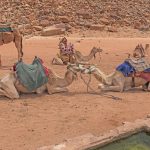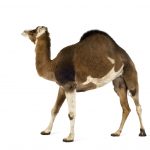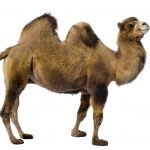Biology is the key to survival in the desert. Camels have evolved amazing biological adaptations to allow them to live and work where most other animals can’t.
How Do Camels Survive In The Desert So Well?
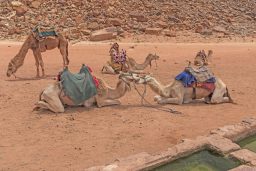
Camels manage so well in a desert environment because of a myriad of special features that give them the advantage. Most of these revolve around water-saving techniques – but self-closing nostrils, heat-proof shoes, air-circulating legs, food-storing humps; sun-screen skin; and jelly-bean blood cells all help to make their desert lives a success.
Basically, if a bunch of scientists was to take into consideration all the things that would make a large animal desert-proof – they would create an almost identical animal to the camel. Although hopefully less smelly?
Why Do Camels Store Fat In Their Hump Not Water?
Storing water in a hump would not help the camels survive any more than it already does. Camels have special water-carry blood cells so they store their water in their veins – they don’t need to put any in their hump.
However, they DO need to store energy somewhere – so they can survive in the desert until they find themselves something tasty to eat again. In a desert, this isn’t always easy to do, so they fill their hump with calories when they have a plentiful feast and then use those calories to feed themselves until they can stock up again elsewhere.
Can A Camel Live Without Food?
No – of course not. Any large mammal needs to have food at some point – however, the camel’s hump allows it to go for a very long time without actually eating anything substantial. Camels can literally live off their own body fat quite naturally.
All of the camel’s fat is stored in one place – the hump – they can use it bit by bit (like raiding the fridge) until it falls flat and they need to top it up again. If they are well watered and not being strongly exercised or worked – they can go for nearly 2 months before their hump empties out.
How Far Can A Camel Walk Without Water?
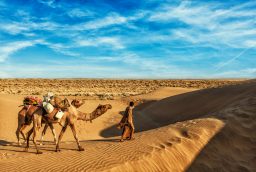
Camels are fantastic at conserving water – as well as being able to extract a lot of water from the food that they eat. As a result, camels can go for a week or more without drinking any freshwater. Which is handy when you are living in a desert.
It is suggested that a well-fed camel can walk a distance of over 160km (100 miles) in a hot desert before it actually needs to top up with fresh water. Wild Bactrian camels can also drink really salty water too without getting ill. It isn’t as hydrating as freshwater – but they can easily desalinate it.
Can Camels Smell Water?
Yes – but no. It has been scientifically discovered that camels can smell a particular molecule found within damp earth – not the water itself. Although the result is the same.
Just as we humans can smell damp earth after digging the garden – camels can smell the same thing – but from WAY further away. Like 3km (1.8 miles).
So, by picking up the scent of damp earth in the desert – they can use their super-sensitive noses to direct them towards the damp area from quite some distance away. Luckily – as they don’t need to drink every day – they don’t need to rush. Just follow the wind to the water. Perfect.
Why Can A Camel Walk On Sand So Easily?
Camels have two giant toes – but walking on your toes in the sand when you weigh the same as a Moose won’t get you very far.
Camels have therefore grown themselves a giant thick pad that acts like a snowshoe. Joining the two toes together and expanding out sideways to nearly 4 times the size of the toes themselves – they have created a heat-proof non-slip covering. No more sinking in the sand.
How Does a Camel’s Water Consumption Help it Survive in the Desert?
The camel’s water consumption explained is a crucial aspect of its survival in the harsh desert climate. With the ability to drink up to 30 gallons of water in one sitting, camels store this precious resource in their humps. This stored water allows them to survive for extended periods without access to drinking water, enabling them to thrive in the arid conditions of the desert.
Can A Camel Outrun A Horse?
In a desert for sure – a camel can outrun a horse.
Camels have long legs for a great pace; no body fat to cause them to overheat; an efficient brain cooling system and of course – those wider feet.
Horses may have the speed on the flat – but camels do better off-road.
Camels have evolved some amazing biological adaptations which allows them to live and work in the desert. A Big feet, Food humps and the ability to conserve water all help for this.


